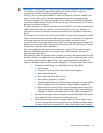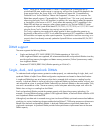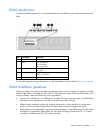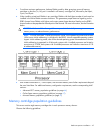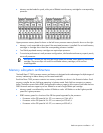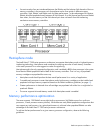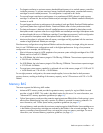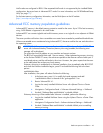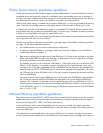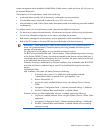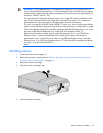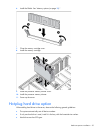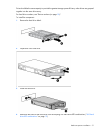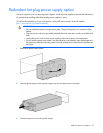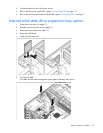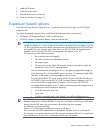Hardware options installation 47
Online Spare memory population guidelines
Online spare memory provides protection against persistent DRAM failure. It monitors DIMMs for excessive
correctable errors and copies the content of an unhealthy rank to an available spare rank in advance of
multi-bit or persistent single-bit failures that may result in uncorrectable faults. Rank-sparing is more efficient
than DIMM-sparing since only a portion of a DIMM is set aside for memory protection.
When Online Spare memory is enabled, the first ranks of DIMM pair, 1A/8A, are set aside as the sparing
ranks. Therefore, the available memory is reduced by the size of the first ranks of DIMM pair 1A/8A.
If a DIMM rank on either of the SMI buses exceeds its correctable ECC threshold, then the contents of the
failing DIMM ranks are copied to the spare DIMM ranks. Once the copy is complete, all memory accesses
to the previous failing DIMM ranks go to the spare DIMM ranks.
No performance penalty occurs for rank-sparing, other than the time it takes to copy the data from the failing
rank to the spare rank upon an error condition.
The following population rules apply to each memory cartridge. Begin with the DIMM installation guidelines
(on page 41) with these additional constraints:
• All installed processors must contain a valid sparing configuration.
• If installing mixed rank DIMMs in a cartridge, follow the mixed rank installation rules of the DIMM
installation guidelines (on page 41).
• Rank sparing requires that the spare ranks of the DIMM pair 1A/8A be at least as large as any other
DIMM rank on the DDR3 channels of the cartridge. To determine the size of a single rank in a DIMM,
divide the total DIMM size by the number of ranks.
For example, the rank size of a dual-rank 2-GB DIMM is 1 GB and the rank size of a dual-rank 4-GB
DIMM is 2 GB. Therefore, it is possible to support rank sparing with mixed DIMM pair sizes in the
cartridge if the 1A/8A pair is populated with the 4-GB DIMMs and the other pairs are populated with
either the identical 4-GB or 2-GB DIMMs (pairs C and D are not required to be populated). In this case,
the 2-GB rank size of the 4-GB DIMMs in the 1A/8A pair is equal to or greater than the rank size of the
other installed DIMMs.
However, the server cannot support DIMM sparing in this example if the 2-GB DIMMs are populated in
the 1A/8A pair locations and the 4-GB DIMMs are populated in any of the remaining DIMM pair
locations. This is because it violates the rule requiring that the spare rank size of DIMM pair 1A/8A (1
GB) be equal to or larger than the single rank size of the other DIMM pair locations, since the rank size
of a 4-GB DIMM in pairs B, C, or D would be larger (2 GB) than the spare rank size of the 2-GB DIMM
pair in 1A/8A (1 GB).
Mirrored Memory population guidelines
Errors that are not corrected by ECC or SDDC cannot be corrected by Online Spare memory. By providing
added redundancy in the memory sub-system, Mirrored Memory provides the greatest protection against
memory failure beyond ECC, SDDC, and Online Spare memory.
In Mirrored Memory mode, each Lockstep DIMM pair of a memory controller (of a memory cartridge
connected to a processor) has a mirrored DIMM pair on the other memory cartridge of the sibling processor
in the same QPI island.
Upon detecting an uncorrectable memory error from a DIMM pair of a memory cartridge, the processor
avoids a system crash by reading the mirrored DIMM pairs from the other memory cartridge. In this case, the



